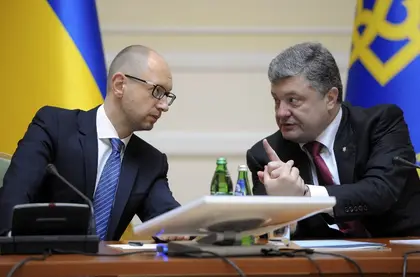Both parties campaigned on the accomplishments of the post-Maidan government and the vote is seen as an affirmation of the current political status quo. The parties are expected to enter into coalition together but question remain about which party will take the lead role in the coalition and what other parties will be included.
Yatsenyuk said he expected to stay on as prime minister heading the pro-Western coalition and that his party should lead talks to form a coalition.
Coalition talks are traditionally led by the largest party in parliament but despite receiving the largest percentage of the party list vote People’s Front will not be the largest party in parliament.

The Ukrainian ballot is split between votes for parties and votes for candidates in single member districts. The Petro Poroshenko Bloc is expected to only receive 63 seats from the party list vote but will pick up another 69 seats in single member districts for a total of 132 seats.
Yatsenyuk’s People’s Front will receive 65 seats from the party list but will only pick up another 18 seats from single member districts, making it the second largest party in parliament with 83 seats.
Poroshenko’s party did not commit to Yatsenyuk being prime minister on Oct. 29 with Deputy Prime Minister and number 4 on the list Volodymyr Hroysman telling journalists that it didn’t matter who would be prime minister and the issue had yet to be discussed.
Experts believe Volodymyr Hroysman is Poroshenko’s own top choice for the prime minister’s chair.
“Yatsenyuk clearly wants to remain prime minister, while Poroshenko seems eager to get his own man, Hroysman in the seat as the new prime minster,” said analyst at Standard Bank in London Timothy Ash.
People’s Front and Poroshenko Bloc have also both released their own competing coalition agreements. The People’s Front’s agreement is five pages where Poroshenko Bloc’s is 48. Both focus on European integration and giving more power to local and regional government.
The parties are also committed to creating a wide coalition including other pro-Western parties that Yatsenyuk said should be called the “European Ukraine coalition.” The parties differ on who exactly should be included in the coalition.
Yatsenyuk emphasized that he considered the Petro Poroshenko Bloc to be a “strategic partner,” but that wants at least three other parties in the coalition including Batkivshchyna, Samopomich and the Radical Party.
Hroysman said they are ready for negotiations and said the collation must include Yatsenyuk’s People’s Front Party, Samopomich and Batkivshchyna as “key partners.” He said Oleh Liashko’s Radical Party joining the coalition would remain “a possibility.”
“Poroshenko Bloc’s people think they will have enough power to form a coalition even without Oleh Liashko Radical Party,” said Vitaliy Bala, a head of the Situations Modeling Agency adding that the Poroshenko Bloc is eager to keep ministerial positions from going to other parties.
Other parties are concerned by these conflicts that seem to have little to do with political ideology and more with influence and risks creating a broad coalition in name only.
Samopomich was the other surprise winner of the election receiving 33 seats and 10.99 percent of the vote after being predicted to barely make it past the 5 percent threshold required to enter parliament. They released a statement on Oct. 29 emphasizing that all coalition members should be involved in drafting the coalition agreement.
You can also highlight the text and press Ctrl + Enter




